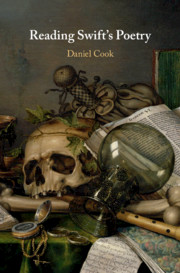Chapter 3 - Love and Books
Published online by Cambridge University Press: 10 August 2020
Summary
In the late 1710s and early 1720s, Swift produced three fairly neglected but potent short poems that break open the typical depiction of romance in verse. ‘Phillis, or, The Progress of Love’ tells the tale of an artful prude who elopes with an unpromising hero. ‘The Progress of Beauty’ presents Celia as a syphilitic nymph rotting to pieces before the narrator can finish her story. ‘The Progress of Marriage’ revels in the misfortunes of a foolish old cleric and his vain wife. If anyone could lay claim to the dubious honour of being Swift’s own muse it was Esther Johnson (“Stella”). Swift wrote her an annual poem for nearly a decade until she died. What sort of love poetry could Swift write? Pretty panegyrics for a younger woman he admired? Profound verse essays on life and love and ageing? Metapoems for a trainee poet? Some important friendships made for difficult poetry. The most noteworthy case in point is doubtless Esther Vanhomrigh, another former tutee, whom Swift immortalized in his longest ever poem. 'Cadenus and Vanessa', like the Stella series, is a remarkable non-love poem that conveys a deeper attachment to the subject than a straightforward parody would imply.
- Type
- Chapter
- Information
- Reading Swift's Poetry , pp. 102 - 135Publisher: Cambridge University PressPrint publication year: 2020

